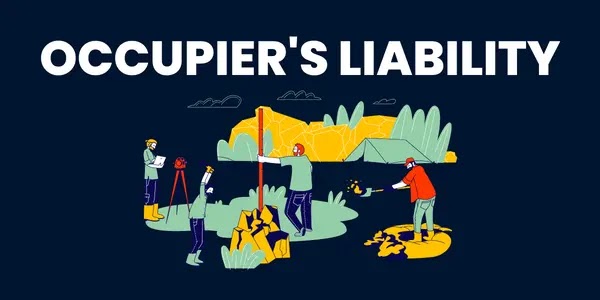Three categories of people are considered under this tort.
Premises
Occupiers
Visitors
Premises
Premises include land, buildings as well as any fixed or moveable structure.
In Wheeler V Copas, the plaintiff was a builder working on the defendant’s property. The defendant gave him a clumsy weak ladder to use which caused him injury as a result.
The court held that the ladder came under the definition of premises but the defendant had no control over it at the time of the accident. It could not be considered that the defendant was an occupier. The plaintiff was to be equally blamed for using a ladder that he knew was weak.
Also Read: Interests in Land
Occupier
An occupier/owner is a party with sufficient control over the premises. To determine who the occupier is the Control Test is used.
In Wheat V E Lacon Co & Ltd [1966], the claimant got injured while on the premises of the defendant. The claimant then sued the manager and the owner of the hotel as dual occupiers. The question before the court was who was the occupier to face the charges. The court determined that both the owner and manager of the hotel were dual occupiers though only the manager was held liable since he was the one in control and available at the happening of the incident.
Visitors
Visitors are people who enter premises such as on land.
Visitors can be categorized as;
a) Express visitors
These are visitors with permission to visit and enter the premises. These can include Invitees and Licensees. For example, a friend you invite for a visit. See The Calgarth
b) Implied visitors
These are visitors with no express permission but whose presence is assumed to be unobjectionable by the occupier i.e., a person entering a shop.
In Lowery V Walker, the plaintiff got injured by a horse while using a shortcut path on the defendant’s premises. The shortcut was for long used by members of the public without objection from the owner (defendant). The defendant owner was aware that the horse was dangerous but took no steps of preventing people from using the path.
Court held that the defendant was liable. Although the plaintiff had no express permission to be on the premises, the plaintiff’s frequent use of the path and the defendant’s acceptance made the plaintiff an implied visitor.
Lawful right visitors
These are visitors who hold a right to enter land whether they have the occupier’s permission or not i.e., Police officers entering premises to effect an arrest. See Section 2(6) of the Occupier’s Liability Act 1957.
OCCUPIER’S DUTY OF CARE
According to Section 2(2) of the OLA 1957, an occupier must take such care in all circumstances of the case as is reasonable to ensure that visitors will be reasonably safe while using their premises for the purposes to which they are invited or permitted to do.
This level of duty of care is similar to that of Negligence.
Children
Skilled Visitors
a) Children
Children are accorded a higher duty of care than the ordinary accorded to other groups of visitors on premises. Section 2(3) (a) of the OLA
Phipps V Rochester Corporation
Glasgow Corporation V Taylor
However, the duty of care will relatively be lower for children who are a bit older.
Titchener V British Railways Board [1983]
b) Skilled Visitors
Less duty of care is accorded to skilled visitors who come onto premises to carry out work related to their expertise. This is provided for by Section 2 (3) (b) OLA. For example, an electrician comes onto premises to repair faulty electricity cables.
Skilled visitors are assumed to have a greater awareness of some risks and the relevant precautions they should take.
However, risks should match the skills of a visitor. An electrician will be owed a lesser duty of care by an occupier only in relation to risks concerned with an electric shock.
General Cleaning Contractors Ltd V Christmas [1953]
c) Trespassers
A trespasser is someone who enters land or premises without permission from the occupier. The occupier must not be aware of the presence of the trespasser or where it is known must be objected to.
Note: A lawful visitor can also be a trespasser after their license to stay on the land expires or the visitor goes beyond what the permission requires of him or her. This can be seen when an invited visitor is told to stay in the living room and they proceed to head to the bedroom.
The general rule is that the occupier does not owe a duty of care to trespassers. This was illustrated in Addie & Sons Ltd V Dumbrek 1929.
However, courts have developed a standard that places a minimum duty of care in relation to a trespasser. The occupier should behave humanely towards the trespasser. Where the occupier does not appreciate the presence of a trespasser on their premises, they should warn the trespasser of the dangers on their land or premises.
DEFENCES
Contributory Negligence
Warning
Violenti non fit Injuria (Voluntary Assumption of Risk)
Notice
Independent Contractor
Warning
Upon knowledge or notice of danger on the occupier’s premises, they must remove the danger or make the visitors on land aware of the said danger. Warning as a defence is only available to the occupier if the plaintiff had the chance to omit or act upon the given warning.
